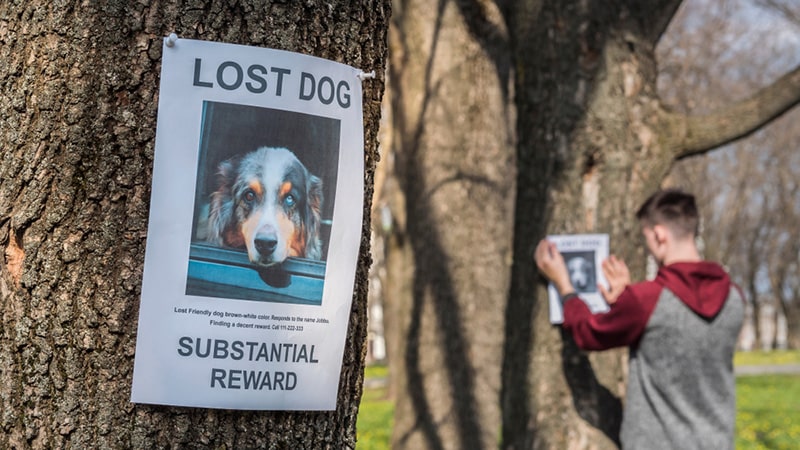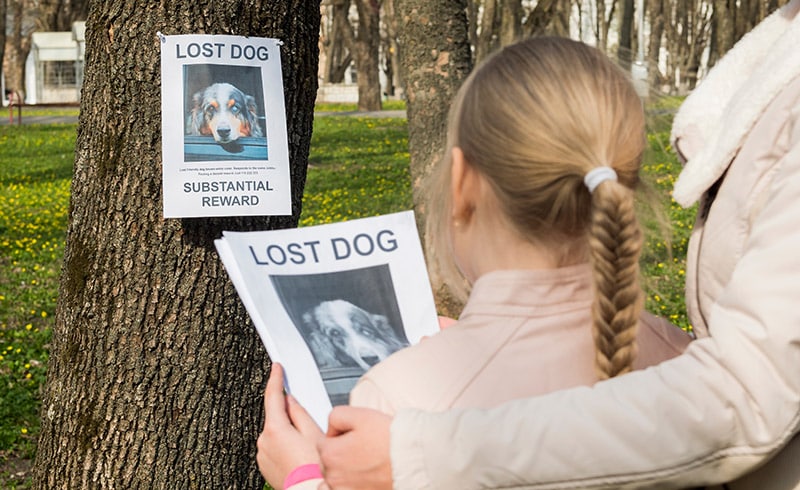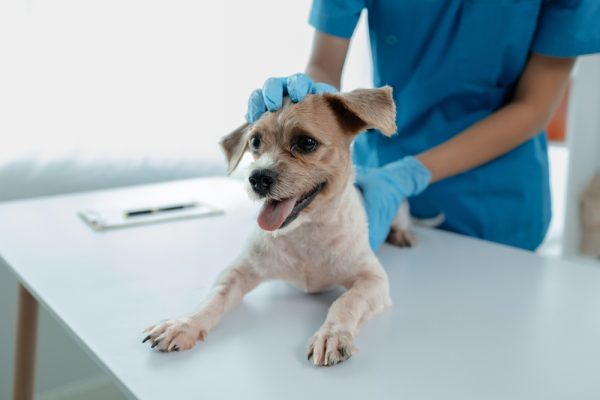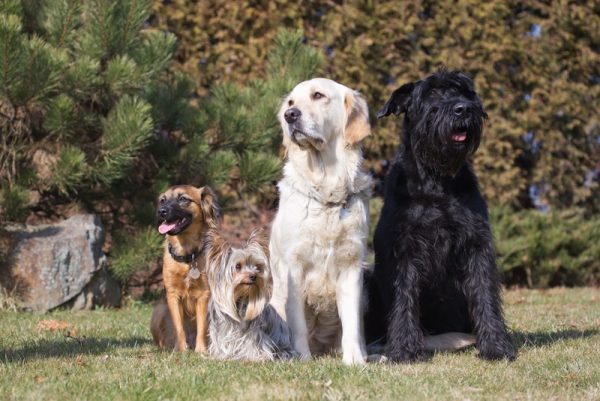In this article
View 2 More +Every pet owner takes care of their pet as best they can. Keeping them safe, healthy, and happy is the top priority, so when you realize that you can’t find your dog, it’s instantly terrifying!
Time is of the essence, so here are the steps that you should take to find your dog and bring them home safe and sound.

The 12 Steps to Take When Your Dog Is Missing
1. Stay Calm and Act Immediately
It’s easy to become agitated and frantic when you realize that your dog is missing, but it’s important to remain calm and focused. You’ll want to take action immediately.

2. Search Inside and Outside Your Home
Before calling for help, start by searching the inside of your house thoroughly. Maybe your dog accidentally trapped themselves in a room or a closet. You should also check your property—under the deck, inside the garage, in the tool shed, and even under bushes. Frightened dogs tend to hide in small places.
3. Bring Treats and a Leash During the Search
Before going out to search, get your dog’s favorite treats and their leash. It can also help to bring a favorite toy and something that smells like them. The treats should be of high value, meaning something that your dog only gets rarely. You’ll want them to be as enticing as possible. Start by searching nearby places that your dog is familiar with.

4. Check With Your Neighbors
Your next step should be speaking to your neighbors. Have them check their backyards, under decks, in the garage, and under their cars. If your neighbors have video surveillance, including Ring cameras, ask them to check the footage in case your dog shows up on it. However, ask your neighbors to stay home and not go out. While this sounds counterintuitive, too many people calling for your dog will likely scare them away. It can make them feel like they are being hunted, so it’s often best to keep the number of physical searchers to a minimum especially if your dog is shy or nervous.
5. Make Flyers
You should make flyers if searching the neighborhood doesn’t turn up your dog. Use large print and a full-body color photo of your dog. Make your phone number big enough to read from a distance, write “Do Not Chase” and your contact info on it, and post the flyers within a 2- to 3-mile radius from where your dog went missing. You can staple them to telephone poles, and ask local pet stores, doggy daycares, and other pet-related businesses if you can post your flyers there.

6. Contact the Authorities
You’ll want to contact animal control, veterinarians, animal shelters, and even police departments within about a 20-mile radius to be on the lookout for your dog. When communicating with them, you should relay your dog’s microchip identification number and go to these places to physically give them your flyers.
7. Put Out Smelly Food
Put pungent food and your dog’s favorite blanket on your deck or next to an open window. The food should be enticing, like bacon or a hot dog. You’ll need to have someone keep an eye on the food, though, since it might draw many other animals, not just—hopefully—your dog.

8. Keep Your Phone With You at All Times
Your phone should be charged and kept with you at all times while searching for your dog. Don’t put your phone on “do not disturb” because any call that you receive might be a sighting of your dog. Keep a notebook nearby too, which you can use to note any sightings:
- Record where and when your dog was sighted.
- Ask if the caller is willing to give you their name and phone number.
- Ask for a description of your dog (to ensure that this is your dog).
- What was your dog doing (running, lying down, etc.)?
- Was your dog on a street or in a park or yard?
Use a map to pinpoint the sighting, which can help you figure out where your dog is traveling to.
9. Post Online
Use a full-body picture of your dog, and post it online on Facebook. There are many groups local to your area that are set up for just this kind of thing. You can try posting on other social media accounts, such as Instagram, too.
There are also websites and apps like:

10. Beware of Scams
If someone calls to tell you that they have your dog but are requesting money (or are asking for the reward that you might have posted), ask them to send you a picture of your dog. It’s also recommended that when advertising for your lost dog, you leave out one thing unique to your dog (like a black patch at the base of the tail or something that wouldn’t show up in a photograph). You can ask the person claiming to have your dog to describe this characteristic. Anyone who can’t give you this information or won’t send you a photo is likely trying to scam you.
11. Check In With Your Microchip Company
Let the microchip company that you use for your dog know that they are missing. Ensure that your contact information has been kept up to date so they can contact you if your dog is found.

12. Don’t Give Up
Sometimes, the worst happens, but there are multiple stories out there of animals being reunited with their owners even years later! Be persistent and systematic in your search for your dog.

What to Do If You Spot Your Dog
Don’t chase them or holler out their name. This is especially important if you have a newly adopted or nervous dog, but even dogs that have known you for years tend not to recognize their owners right away. Lost pups may go into survival mode and run away from you.
You may need to avoid eye contact and sit on the ground. You should have your dog treats on you, which you should gently throw in your dog’s direction to get them closer. Your dog will be able to recognize you once they are close enough to smell you, but you shouldn’t make any movement until your dog is close enough to get the leash on without them running off again.
If this doesn’t work, call your local rescue group or animal control officer to ask for help. Keep your eyes on your dog; the professionals can help catch them with their specialized equipment.
Prevention Is Essential
You must ensure that your dog has a collar and tags that you keep updated if your information changes. It should have your address and telephone number. If your dog isn’t microchipped, it’s highly recommended that you do this as soon as possible! If your dog is found, they are typically brought to local animal shelters or veterinarians, who will immediately scan them for a microchip. You can also try a GPS tracker, which will show you where your dog is at all times.

Conclusion
Having your dog go missing is every pet owner’s nightmare! You are likely feeling stressed and scared, but this is when you must act quickly! The faster you act, the more likely you’ll find your pet, since they won’t have gotten away too far. Getting the professionals in your community involved will increase the likelihood of finding your dog.
If you do spot your pet, remember not to chase them. Get down low, and use the treats to entice them to come closer. Hopefully, you’ll have your dog back home with you, safe and sound, in no time!
Related stories:
- Wait, Now the Cops Can Fine You For Putting Up Posters of Your Lost Dog?
- Tractive Dog GPS Tracker Review: An Expert’s Breakdown
Featured Photo Credit: StockMediaSeller, Shutterstock


















